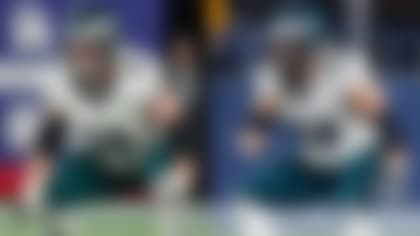Ronald Curry remembers in 2003, after his rookie season, that offseason day when Oakland Raiders coaches summoned him and asked, "What position do you want to play?"
And followed that up with, "And it won't be quarterback."
Maybe Curry, now a Detroit Lions wide receiver, knew that day would come for him. Most college quarterbacks who struggle in the NFL expect rejection. Only a handful can convert to safety, cornerback or wide receiver.
From signal-callers to pass-catchers
Marlin Briscoe: He left Nebraska-Omaha hoping to make his mark as a quarterback. He did. In 1968 with the Denver Broncos, he became the first African-American quarterback to start in a professional football game. But for most of his nine-year pro career, which ended in 1976, he was a wide receiver.
Freddie Solomon: The Tampa University quarterback made the switch to NFL wide receiver for the Miami Dolphins (1975-77) and the San Francisco 49ers (1978-85). He was the intended receiver on the Joe Montana pass that ended up being caught by Dwight Clark in the classic 1982 NFC Championship Game between the 49ers and Dallas Cowboys. The play has been dubbed "The Catch."
Antwaan Randle El: The former Indiana University quarterback has become a fixture as an NFL wide receiver, first with the Pittsburgh Steelers (2002-2005) and now with the Washington Redskins. In February 2006, he used pro football's ultimate stage to draw from his quarterback roots and, on a reverse, tossed a 43-yard touchdown pass that helped clinch the Steelers' Super Bowl XL victory over the Seattle Seahawks.
Anquan Boldin: He entered Florida State as a quarterback and played wide receiver there before making the transition in earnest in the NFL in 2003 with the Arizona Cardinals. It was a stellar start -- he was the only rookie to earn Pro Bowl honors that season, and he also was the NFL Rookie of the Year. He has become one of the NFL's most physical and productive receivers.
Joshua Cribbs: A versatile quarterback at Kent State, he has earned his keep in the NFL as a kick returner extraordinaire after the Cleveland Browns signed him as an undrafted free agent in 2005. The Browns look to use him more as a wide receiver next season.
Isaiah Stanback: He was always under center at the University of Washington, but when the Cowboys drafted him in the fourth round in 2007, that move was all about turning him into a receiver. The transition continues: In two seasons, he has played in 10 games with no starts and made two catches for 24 yards.
Brad Smith: He enters his fourth NFL season, and this could be a distinguishing year for the former Missouri quarterback. He has played in 47 of a possible 48 regular-season games, with 13 starts, in his three seasons with the New York Jets, and his career numbers -- 53 catches, 450 receiving yards, two touchdown grabs and 42 rushing attempts -- illustrate his promise.
Often the choice is wide receiver.
The NFL has a controversial and colorful experience -- past and present -- of college quarterbacks-turned-wide receivers. In harsher times for black quarterbacks, the move was a given, based on prejudice and ignorance. Nowadays, black quarterbacks more often get a shot, then later make the move in earnest if they see that is where their NFL future lies.
Like Curry.
"You come out of college thinking you are a quarterback, you will be a quarterback and all you want is a chance to succeed or fail," Curry said. "I was on the practice squad my first year with the Raiders, and I was the scout-team quarterback whenever we played a mobile quarterback. I didn't get a lot of chances to show what I could do, but at least I earned a shot. Teams wanted me to play safety at the combine before the draft. I said no. They wanted me to work out at safety at my pro day. I said no. But once I got with the Raiders and at least had a year at the position, I was willing."
Curry sees a current version of himself in Pat White, the former West Virginia quarterback who was drafted by the Miami Dolphins last April. Curry is eager to see how White develops, if he will be given the chance to play quarterback and learn. Curry wonders if White will be given a season at the position in a reserve role and, like himself, be moved to wide receiver.
The Dolphins currently list White only as a quarterback.
White's early camp performances have provided an expected mixture, the type of highs and lows that most rookies experience. He has struggled with his accuracy but has shown a nice touch on deep passes. Dolphins coach Tony Sparano said: "Until I see something different out here, he's a quarterback." White said "right now" his focus is quarterback, that is what his coaches are focusing on and "we'll see where that goes."
A veteran NFL personnel executive who scouted White thoroughly throughout his college career said the key words from that are "right now." He believes White will wind up much like Curry. So do other NFL scouts, who were surprised the Dolphins chose White so high -- in the second round, 44th overall.
"My initial reaction was this was a total Wildcat offensive move by the Dolphins, and for that attack, he can be a perfect guy," the executive said. "He is an excellent runner, and you have to respect his throwing more than you do others who run the Wildcat. I have seen him up close, and I am not impressed with his arm strength or his accuracy. I don't think he is going to be a full-time NFL quarterback. He can be better than some quarterbacks who turn to wide receiver, and I think that is where he will wind up playing the most for his career."
White hopes to change those views.
Curry tried but found another niche.
From 1995 through 1997, Curry was one of Virginia's best-ever high school quarterbacks (a 51-2 record and three state titles). He played quarterback at the University of North Carolina. But Raiders owner Al Davis has said he drafted Curry in the seventh round in 2002 as much for his high school wizardry as anything he accomplished in college.
Curry's time with the Raiders was uneven -- six touchdown catches in 2004, then 62 catches in 2006, then 55 catches and four touchdown grabs in 2007, but too many injuries along the way and, last season, too many dropped balls.
In 1968, former NFL wide receiver Gene Washington made the move from quarterback to wide receiver while at Stanford. He became a first-round NFL pick who played for the San Francisco 49ers (1969-1977) and the Lions (1979). Washington amassed 385 catches, 60 touchdowns and four Pro Bowl selections.
"If you are an athletic quarterback, over time, you can learn the receiver position," Washington said. "But there is no substitute for time and experience in that situation. You need a patient coach and a patient team. It's learning the body control, the footwork. The balance. I'd say 90 percent of it is that and 10 percent is catching the ball, which is the mental part. But there are times catching the ball, the mental part, becomes the 90 percent.
"You have a slight advantage in the transition in that you know what the quarterback is thinking, you know his point of view. A lot of receivers think if they just get open, that's it. But they don't see the game from the quarterback's eyes. Good receivers think like quarterbacks think."
Curry said he thinks like that.
Curry said he had to "adjust his body" to play wide receiver. He had to adjust to the running, the constant movement, the hits. He said he had to realize that playing wide receiver is as much an art as playing quarterback.
Curry was ready for a change, as much as the Raiders were ready to move on this offseason. He said the Lions will use him more in the slot position, unlike how the Raiders insisted upon play-action and an "outside offense." He likes that. Curry, 30, is ready for his eighth NFL season, eager to continue his makeover.
"It's a fairer climate now for quarterbacks to get their chance, and I think Pat White is going to get that, especially with him being such a high draft pick," Curry said. "I think the lower you are drafted, the more difficult it is to stay at quarterback in the league, especially if you have the skills to play wide receiver. You have to roll with it.
"It's like our coaches are saying here: This is about a new day, nothing about 0-16, a chance to run a new system with new guys and a new approach and make bigger and better NFL history," Curry said. "It's a chance for every player to invent himself. I know how to do that."




